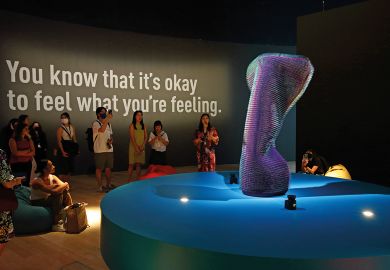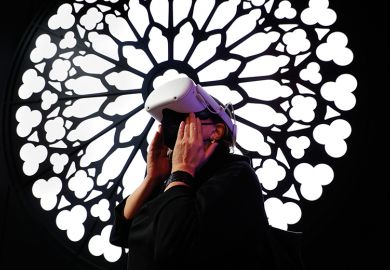Source: Alamy
A merged model: San José State has been experimenting with combining classroom and online education, and it cites impressive improvements in the proportion of students who advance to the next level
Located in the heart of high-tech Silicon Valley, San José State University is a combination of early 19th-century red-tiled Spanish Revival-style architecture and modern, shiny research, teaching and library buildings.
It is also at the centre of one of the biggest debates in US higher education, thanks to an experiment that is combining conventional and online learning.
As administrators and politicians push to provide online courses that they say will take the pressure off underfunded and oversubscribed conventional ones, some academics - including philosophy scholars at San José State - are pushing back.
In some disciplines, the professors say in an open letter, online courses are turning faculty members into glorified teaching assistants.
In the California State Senate, a bill has been introduced that would open the door for students who cannot get into entry-level courses to sit the same subjects provided by online players (including for-profit companies) approved by a committee of academics.
Years of budget cuts in California and other states have clogged the pipeline to and through these “gateway” courses, costing students time and money.
But the bill alarms some scholars, who fear that the massive economies of scale made possible by online education could imperil their control of the curriculum, not to mention their jobs.
They also say that the controversy misses a significantly more important point: public higher education is being starved of money.
“This has been a gigantic distraction,” says Bob Samuels, president of the University Council-American Federation of Teachers, a union that represents some academic staff working in the University of California system.
After five years during which funding for public universities in the state has been slashed by about $1 billion (£650 million), Samuels says, the sector is now being told to solve its problems with a “magical techno- bullet”.
He argues that the proposal to replace bricks-and-mortar courses with online ones is “part of a larger culture of bashing teachers” and a way to circumvent academic control and its careful development of curricula.
“It’s taking away attention from our real problems,” he argues.
However, despite such arguments, the momentum seems to be with forms of web-based provision, particularly massive open online courses.
“Faculty have been resistant to change for some time,” says Gabi Zolla, vice-president for programmes, research and policy at the Council for Adult and Experiential Learning, a not-for-profit organisation that is pressing universities to award academic credit for students’ life and work experience. “This isn’t new. It doesn’t mean that early adopters can’t change the tide.”
This includes San José State. One of California’s overcrowded public universities, the institution has already been experimenting with combining classroom and online education, and it points to impressive improvements in the proportion of students who pass and advance to the next level.
“When we talk about a lot of our face-to-face systems, I don’t think we can call them perfect,” says the university’s president, Mohammad Qayoumi. “We should look at other ways we can improve the engagement…and success rates of the students.
“Online education is not going to solve all our problems. It may not fit everybody or be appropriate in every discipline. But the only way you can know is to try it.”
‘Dystopian’ vision
Not everyone on campus agrees. In its open letter, the San José State philosophy professors object to the idea of having their students use a Mooc version of a course taught at Harvard University.
For one thing, the letter says, students at an elite Ivy League university and those at an ethnically diverse urban institution may not respond in the same ways or be interested in the same things.
“The thought of the exact same social justice course being taught in various philosophy departments across the country is downright scary - something out of a dystopian novel,” the professors write.
But their principal objection is that they are being edged out.
“Let’s not kid ourselves; administrators at the [California State University system] are beginning a process of replacing faculty with cheap online education,” they write.
Public universities are resorting to it to “replace professors, dismantle departments, and provide a diminished education for students in public universities”.
Academics in other parts of the US have joined the chorus of disapproval. At Duke University, a private institution based in Durham, North Carolina, the undergraduate faculty council blocked a plan under which students would take online courses from a for-profit company.
These high-fee-paying students would get “neither the advantages of self- paced learning nor the responsiveness of a professor who teaches to [their] passions and curiosities”, 75 academics wrote in a letter to The Chronicle, Duke’s student newspaper.
At Amherst College, a private institution based in Massachusetts, academics rejected a plan to join the edX Mooc platform, which is backed by the Massachusetts Institute of Technology and Harvard, on the grounds that they had no control over the content of courses produced by other universities.
However, according to Qayoumi, when online education is combined with the conventional kind, the results are better than from either model working on its own.
“You have short snippets of lecture material with a series of questions,” he says. “So in the beginning the instructor is giving big challenges to make the students think why they are trying to learn something, then giving them small pieces of lectures, then asking questions. It’s far more engaging.”
By studying the process, Qayoumi argues, “we can design almost an individualised system that will enhance the success of students”.
And yes, he adds, it also increases the university’s capacity.
“If I have a small lab that can hold 50 students and I can virtualise half of that lab, I can accommodate 100 students.”
He concedes that these methods “may not work as well in some of the humanities courses, or perhaps there are other approaches that could work”.
As for the philosophy department’s concerns, he responds: “Could we take parts of those [Harvard] lectures and do the rest of the courses locally? Or could we join with other universities in the local area and build courses to enhance the student experience? We’re not twisting arms. But the only way you find out is by trying.”
After all, it is unlikely that public university budgets will be restored to previous levels, Qayoumi says.
“That does not mean we should stop our advocacy, but we should also be realistic,” he adds. “Nobody in the US or other Western countries has any appetite for major tax increases. We have so many competing needs.
“And now that we have so many new technologies, why shouldn’t we try to see [whether] they help us make some breakthroughs with limited resources? Otherwise you would only be educating a much, much smaller number of people than we are being called upon to educate.”
Advocates of Moocs do not seem worried that academic protests will significantly slow the platforms’ breakneck growth.
“Certainly there are many great classes. And if you have an opportunity to sit around a table with a great instructor, there’s no better education than that,” says Daphne Koller, co-founder of Coursera, one of the biggest Mooc providers, which is based at Stanford University, another Californian institution.
“There are a very large number of classes that could benefit from the introduction of technology.”
Koller, a professor in Stanford’s computer science department, says she is all for academic discretion, but adds that “we have a crisis in California, where students wait 18 months to get into Calculus I and other gateway courses”.
“I don’t think you should have an allergic reaction to a course just because it is taught online.”
Register to continue
Why register?
- Registration is free and only takes a moment
- Once registered, you can read 3 articles a month
- Sign up for our newsletter
Subscribe
Or subscribe for unlimited access to:
- Unlimited access to news, views, insights & reviews
- Digital editions
- Digital access to THE’s university and college rankings analysis
Already registered or a current subscriber? Login




